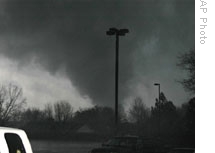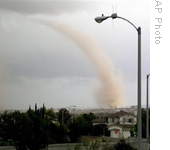VOA慢速英语-SCIENCE IN THE NEWS - This Year May Set Record for T
时间:2019-01-11 作者:英语课 分类:VOA慢速英语2008年(七)月
More than 115 storm-related deaths have already been reported, making 2008 the deadliest year for tornadoes 3 in the past 10 years. Transcript 4 of radio broadcast:
14 July 2008
VOICE ONE:
This is SCIENCE IN THE NEWS in VOA Special English. I'm Bob Doughty 5.
VOICE TWO:

Funnel 6 cloud of a tornado 2 that touched down in February in Atkins, Arkansas. Tornadoes hit four southern states in a rare burst of violent winter weather that killed at least 15 people.
And I'm Shirley Griffith. On our program this week, we will tell about the science of tornadoes. Tornadoes have been observed in many parts of the world. But the storms are most often found in the United States. American weather experts say this year may set records for tornadoes and tornado deaths.
(MUSIC)
VOICE ONE:
A tornado is a violently turning tube of air suspended 7 from a thick cloud. It extends 9 from a thunderstorm in the sky down to the ground. The shape is like a funnel: wide at the top, narrower at the bottom.
Tornadoes form when winds blowing in different directions meet in the clouds and begin to turn in circles. Warm air rising from below causes the wind tube to reach toward 10 the ground. Because of their circular 11 movement, these severe windstorms are also known as twisters.
The most severe tornadoes can reach wind speeds of three hundred twenty kilometers an hour or more. In some cases, damage paths can stretch more than one kilometer wide and eighty kilometers long.
VOICE TWO:
With a tornado, bigger does not necessarily 12 mean stronger. Large tornadoes can be weak. And some of the smallest tornadoes can be the most damaging. But no matter what the size, tornado winds are the strongest on Earth. Tornadoes have been known to carry homes, cars and trees from one place to another. And they can also destroy anything in their path.
Tornadoes have been observed on every continent except Antarctica. But weather experts say the country where they are most common is the United States. Each year, the United States has more than one thousand tornadoes.
VOICE ONE:

A man searches through the remains 13 of a house destroyed by a tornado in Picher, Oklahoma, in May
On average, tornadoes cause about seventy deaths and one thousand five hundred injuries in the United States each year. But weather experts say two thousand eight may set records for tornadoes and tornado-related deaths. Officials have already reported more than one hundred fifteen such deaths this year. This has been the deadliest year for the violent windstorms since nineteen ninety-eight.
Weather experts say unusually severe weather this winter and early spring may be to blame. Starting on February fifth, eighty-seven tornadoes struck the Tennessee Valley and central United States over a twenty-four hour period. Those storms resulted in fifty-six deaths. The experts also note that several tornadoes struck areas where large numbers of people live, causing more deaths and injuries.
(MUSIC)
VOICE TWO:
Tornadoes are observed most often in the central part of the United States, where the land is mostly flat. The area where the most violent tornadoes usually happen is known as “Tornado Alley 14. ”This area is considered to extend 8 from north central Texas to North Dakota.
Tornadoes can happen any time of the year. But most happen from late winter to the middle of summer. There is a second high season in November.
VOICE ONE:
During spring, warm air moves north and mixes with cold air remaining from winter. In November, the opposite happens. Cold weather moves south and combines with the last of the warm air from summer.

A tornado touches down in Riverside, California, in May
Tornadoes can strike with little or no warning. Most injuries happen when flying objects hit people. Experts say the best place to be is in a small room, without windows, in the middle of the lowest part of a building.
People driving during a tornado are told to find low ground and lay flat, face down, with their hands covering their head. People in the path of a tornado often have just minutes to make life-or-death decisions.
VOICE TWO:
The deadliest American tornado on record is the Tri-State Tornado of March eighteenth, nineteen twenty-five. It tore across Missouri, Illinois and Indiana. About seven hundred people were killed.
A "tornado outbreak" is often defined 15 as six or more tornadoes produced by the same weather system within a day. But the outbreak of April third and fourth, nineteen seventy-four, set a national record. It is remembered as the "Super Outbreak. "
One hundred forty-eight tornadoes struck during a twenty-four-hour period. More than three hundred people were killed and six thousand others were injured.
One tornado that was especially destructive 16 hit Xenia, Ohio. The sound you are about to hear comes from the Web site www.xeniatornado.com.
(SOUND)
VOICE ONE:
No two tornadoes look exactly the same. And no two tornadoes act the same way.
It takes the right combination 17 of wind, temperature, pressure and humidity 18 to create even a weak tornado. Weather experts can identify these conditions. And, when they observe them, they can advise people that tornadoes might develop. But they are not able to tell exactly where or when a tornado will hit. Tornado warnings still depend in large part on human observations.
Usually a community will receive a warning at least a few minutes before a tornado strikes. But each year there are some surprises where tornadoes develop when they are least expected.
VOICE TWO:
The tornado reporting system involves watches and warnings. A tornado watch means tornadoes are possible in the area. A tornado warning means that a tornado has been seen. People are told to take shelter immediately.
Yet tornadoes can be difficult to see. Sometimes only the objects they are carrying through the air can be seen. Some nighttime tornadoes have been observed because of lightning strikes nearby. But tornadoes at night are usually impossible to see.
Tornadoes that form over water are called waterspouts. But tornadoes cover a much smaller area than hurricanes, which form over oceans.
Tornadoes can be measured using wind speed information from Doppler radar 19 systems. Tornadoes usually travel in a northeasterly direction with a speed of thirty-two to sixty-four kilometers per hour. But they have been reported to move in other directions and as fast as one hundred seventeen kilometers an hour.
VOICE ONE:
In the United States, the force of a tornado is judged by the damage to structures. Scientists inspect the damage before they estimate 20 the severity of a tornado. They measure tornadoes on the Fujita scale. Ted 1 Fujita was a University of Chicago weather expert who developed this system in the nineteen seventies.
There are six levels on the Fujita scale. Tornadoes that cause only light damage are called an F-zero. Those with the highest winds that destroy well-built homes and throw vehicles more than one hundred meters are called an F-five.
(MUSIC)
VOICE TWO:
Some people make a sport out of watching and following tornadoes. They are called tornado chasers or storm chasers. Their work can be seen in the extreme weather videos that are increasingly 21 popular on television.
Some chasers are part of weather research teams. Others do it to help document storms and warn the public. Still others do it just because it is their idea of fun.
Storm chasers usually drive large vehicles to areas of severe weather. They follow storms for long distances. For some, the appeal of a tornado is to get closer and take better pictures than others have, without getting killed in the process.
VOICE ONE:
The National Weather Service says the United States gets more severe weather than any other country. For one thing, it is also bigger than most other countries. And it has many different conditions that create many different kinds of weather.
There are seacoasts and deserts, flatlands and mountains. The West Coast is along the Pacific Ocean, which is relatively 22 calm. The East Coast is along the Atlantic Ocean, which is known for its hurricanes. These strike mainly the Southeastern states.
The hurricane season officially began on June first and ends on November thirtieth.
(MUSIC)
VOICE TWO:
This SCIENCE IN THE NEWS was written by Brianna Blake, who was also our producer. I'm Shirley Griffith.
VOICE ONE:
And I'm Bob Doughty. Read and listen to our programs at voaspecialenglish. com. And if you have a science question, send it to special@voanews. com. We might be able to answer it on our show. Join us again next week for more news about science in Special English on the Voice of America.
- The invaders gut ted the village.侵略者把村中财物洗劫一空。
- She often teds the corn when it's sunny.天好的时候她就翻晒玉米。
- A tornado whirled into the town last week.龙卷风上周袭击了这座城市。
- The approaching tornado struck awe in our hearts.正在逼近的龙卷风使我们惊恐万分。
- Tornadoes, severe earthquakes, and plagues create wide spread havoc. 龙卷风、大地震和瘟疫成普遍的毁坏。 来自互联网
- Meteorologists are at odds over the working of tornadoes. 气象学者对龙卷风的运动方式看法不一。 来自互联网
- A transcript of the tapes was presented as evidence in court.一份录音带的文字本作为证据被呈交法庭。
- They wouldn't let me have a transcript of the interview.他们拒绝给我一份采访的文字整理稿。
- Most of successful men have the characteristics of contumacy and doughty.绝大多数成功人士都有共同的特质:脾气倔强,性格刚强。
- The doughty old man battled his illness with fierce determination.坚强的老人用巨大毅力与疾病作斗争。
- He poured the petrol into the car through a funnel.他用一个漏斗把汽油灌入汽车。
- I like the ship with a yellow funnel.我喜欢那条有黄烟囱的船。
- A lamp was suspended from the ceiling. 一盏吊灯悬在天花板上。
- The British government has now suspended humanitarian aid to the area. 英国政府现已暂停对这一地区的人道主义援助。
- Can you extend your visit for a few days more?你能把你的访问再延长几天吗?
- The examinations extend over two weeks.考试持续两个星期。
- This country extends its power and influence into neighbouring countries. 这个国家将其势力与影响扩大至邻国。 来自《简明英汉词典》
- His domain extends for 20 miles in every direction. 方圆20英里之内都是他的地产。 来自《简明英汉词典》
- Suddenly I saw a tall figure approaching toward the policeman.突然间我看到一个高大的身影朝警察靠近。
- Upon seeing her,I smiled and ran toward her. 看到她我笑了,并跑了过去。
- The bright boy altered it to a circular form.这个聪明的男孩把它改成了圆形。
- The lamp stands on a circular base.这盏台灯是装在圆形底座上的。
- More work does not necessarily call for more men.增加工作量不一定就要增添人员。
- A voter must necessarily be no younger than eighteen.选民必须在18岁以上。
- He ate the remains of food hungrily.他狼吞虎咽地吃剩余的食物。
- The remains of the meal were fed to the dog.残羹剩饭喂狗了。
- We live in the same alley.我们住在同一条小巷里。
- The blind alley ended in a brick wall.这条死胡同的尽头是砖墙。
- These categories are not well defined. 这些类别划分得不太明确。
- The powers of a judge are defined by law. 法官的权限是由法律规定的。
- In the end,it will be destructive of our whole society.它最终会毁灭我们整个社会。
- It is the most destructive storm in 20 years.这是20年来破坏性最大的一次风暴。
- He carried on the business in combination with his friends.他与朋友们合伙做生意。
- The materials can be used singly or in combination.这些材料可以单独使用也可以混合用。
- The house is not comfortable tonight ,because of the high humidity.由于湿度高,今晚屋子里不舒服。
- It's difficult to work because of the humidity.由于空气潮湿,工作很困难。
- They are following the flight of an aircraft by radar.他们正在用雷达追踪一架飞机的飞行。
- Enemy ships were detected on the radar.敌舰的影像已显现在雷达上。
- We estimate the cost to be five thousand dollars.我们估计费用为5000美元。
- The lowest estimate would put the worth of the jewel at $200.按最低的评估这块宝石也值200美元。
- Rivers are being increasingly made use of by man. 河流正在日益为人类所利用。
- I find it increasingly difficult to live within my income.我发现靠收入过日子越来越难了。
- The rabbit is a relatively recent introduction in Australia.兔子是相对较新引入澳大利亚的物种。
- The operation was relatively painless.手术相对来说不痛。